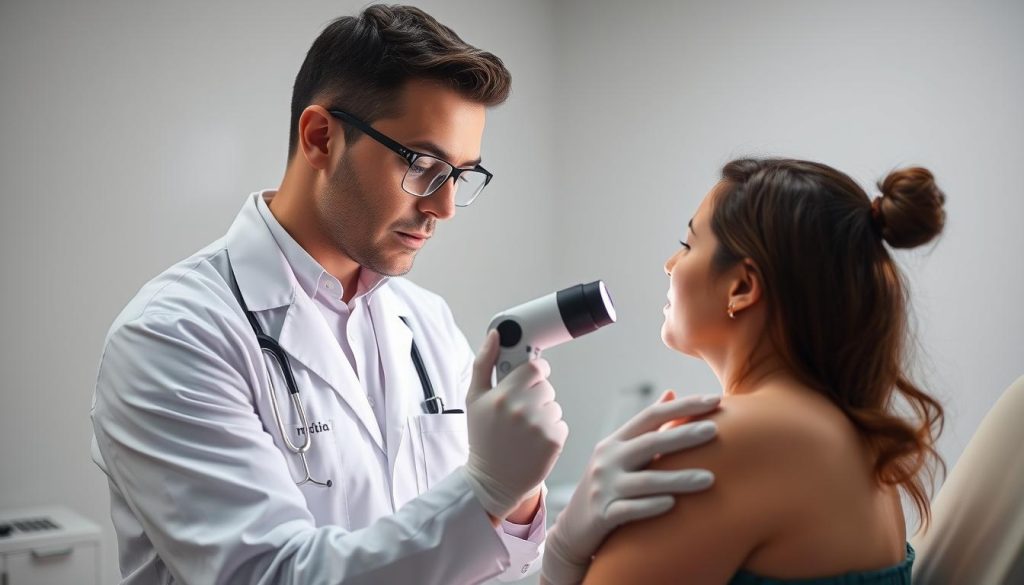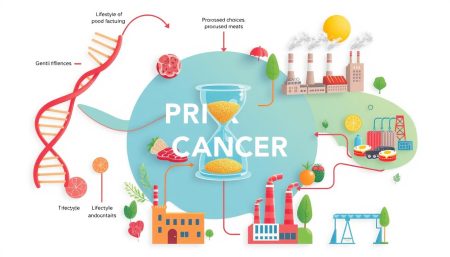Melanoma cancer is a serious skin cancer that needs our focus. It can show up suddenly, catching many off guard. It’s important to know its signs and treatment options.
Spotting melanoma early is key to treatment success. Many don’t realize that small skin changes can be serious. Learning to recognize these signs helps us detect and manage melanoma early.
In this guide, we’ll explore melanoma cancer in depth. We’ll cover its basics and the latest treatments. Our goal is to give you a full understanding of this challenging skin cancer. Join us as we uncover the details and prepare you to tackle it.
What is Melanoma Cancer: Understanding the Basics
Melanoma cancer is a serious skin cancer. It starts in melanocytes, the cells that make our skin’s pigment. This cancer can be aggressive and dangerous if not treated early.
The Biology of Melanoma Formation
Melanoma happens when melanocytes get damaged DNA. This damage often comes from UV radiation from the sun or tanning beds. As these cells grow, they can spread to other parts of the body.
Types of Skin Cells Affected
Melanoma mainly affects melanocytes. But it can also harm other skin cells. The main types of skin cells involved in melanoma include:
- Melanocytes: Produce melanin, giving skin its color
- Keratinocytes: Form the outer layer of skin
- Fibroblasts: Produce collagen and elastin
Risk Factors and Genetic Predisposition
Many factors can increase the risk of melanoma cancer. Dermatology experts say the following are key risk factors:
| Risk Factor | Description |
|---|---|
| UV Exposure | Prolonged sun exposure or tanning bed use |
| Fair Skin | Less melanin provides less protection from UV rays |
| Family History | Genetic mutations can be inherited |
| Multiple Moles | Higher number of moles increases risk |
| Weakened Immune System | Reduced ability to fight abnormal cell growth |
Knowing the basics of melanoma cancer helps people spot risks early. This can lead to better treatment and recovery chances.
Early Warning Signs of Skin Cancer
Spotting skin cancer early can save lives. It’s key to check your skin often for cancer symptoms. Look for changes in moles or new skin lesions.

- Changes in mole size, shape, or color
- Asymmetrical or irregular borders on skin growths
- New spots or lesions that don’t heal
- Itching, bleeding, or crusting on existing moles
The ABCDE rule helps spot melanoma cancer. It stands for Asymmetry, Border irregularity, Color changes, Diameter over 6mm, and Evolving appearance.
| Warning Sign | Description |
|---|---|
| Asymmetry | One half of the mole doesn’t match the other |
| Border | Edges are ragged, notched, or blurred |
| Color | Uneven coloration or multiple colors present |
| Diameter | Larger than 6mm (about the size of a pencil eraser) |
| Evolving | Changes in size, shape, or color over time |
If you see any of these signs, see a dermatologist fast. Catching skin cancer early, like melanoma, can greatly help treatment and survival chances.
The ABCDE Rule of Melanoma Detection
Early detection is key in fighting melanoma cancer. The ABCDE rule is a helpful tool for spotting skin cancer early. It guides you in identifying signs of melanoma, leading to quicker treatment.
Asymmetry in Skin Lesions
Melanomas often don’t look like regular moles. Try drawing a line through the mole. If the two sides don’t match, it might be a sign of skin cancer.
Border Irregularity
Healthy moles have smooth edges. But melanomas have jagged or notched borders. Watch for any odd shapes on your skin.
Color Variations
Normal moles are usually one color. But melanomas can have many colors, like brown, black, red, white, or blue. If a mole has different colors, it’s worth checking closer.
Diameter Concerns
Most melanomas are bigger than 6mm, about the size of a pencil eraser. But they can start small. Regular checks help spot size changes.
Evolution and Changes Over Time
Any change in a mole’s size, shape, color, or height is a concern. Also, watch for new symptoms like itching, crusting, or bleeding. These need a doctor’s attention right away.
| ABCDE Factor | Normal Mole | Potential Melanoma |
|---|---|---|
| Asymmetry | Symmetrical | Asymmetrical |
| Border | Smooth, even | Irregular, jagged |
| Color | Uniform | Multiple colors |
| Diameter | Usually <6mm | Often >6mm |
| Evolution | Stable | Changes over time |
Common Locations Where Melanoma Develops
Melanoma cancer can show up in many places on the body. It’s important to check your skin often. Sun exposure is a factor, but melanoma can also pop up in unexpected spots. Knowing where it often appears helps catch it early and get the right care.

The back is a common place for melanoma in men. Women often see it on their legs. The face and arms, which get a lot of sun, are also common. But don’t forget about the palms, soles, and under nails. These areas can also get melanomas.
Here’s a breakdown of melanoma occurrence by body location:
| Body Area | Percentage of Melanomas | Risk Factors |
|---|---|---|
| Back | 30% | Frequent sunburns, mole presence |
| Legs | 20% | Sun exposure, tanning bed use |
| Arms | 15% | Outdoor activities, lack of sunscreen |
| Face | 10% | Cumulative sun damage, aging |
| Chest | 10% | Sunbathing, genetic factors |
| Other areas | 15% | Varied, including genetic predisposition |
It’s key to do self-exams and get skin checks from a pro. Look at all parts of your body, not just sun-exposed areas. If you see anything odd, see a dermatologist right away.
Stages of Melanoma Cancer Development
Knowing about melanoma stages is key for good cancer care. Doctors use a system to see how far the cancer has spread. Let’s look at the different stages of melanoma.
Stage 0 (In Situ)
At Stage 0, cancer cells are only in the skin’s top layer. The tumor hasn’t grown deeper or spread. Catching it early can lead to successful treatment.
Stage I Melanoma
In Stage I, the tumor is small and hasn’t spread. It may have grown a bit deeper into the skin. Finding melanoma early at this stage usually means a good outcome.
Stage II Melanoma
Stage II melanomas are bigger and deeper in the skin. They haven’t spread to lymph nodes or other parts of the body. But, they have a higher chance of coming back after treatment.
Stage III Melanoma
At Stage III, the cancer has reached nearby lymph nodes but not distant sites. Treatment gets more intense, including surgery and systemic therapies.
Stage IV Melanoma
The most advanced stage, where cancer has spread to distant organs like the lungs, liver, or brain. Treatment aims to extend life and manage symptoms.
| Stage | Tumor Depth | Lymph Node Involvement | Distant Spread |
|---|---|---|---|
| 0 | Top layer only | No | No |
| I | Up to 2mm | No | No |
| II | Over 2mm | No | No |
| III | Any depth | Yes | No |
| IV | Any depth | Any | Yes |
Diagnostic Methods and Testing
Finding cancer early is key for treating melanoma well. Doctors use many ways to spot and check melanoma cancer. Let’s look at the main ways to find melanoma.
Physical Examination Techniques
Doctors do detailed skin checks to find odd moles or spots. They use special tools to look at skin texture, color, and edges. This first step helps find possible melanoma for more tests.

Biopsy Procedures
Biopsies are vital to confirm melanoma. Doctors take a piece of suspicious tissue for lab tests. There are a few types:
- Shave biopsy: Takes off the top skin layers
- Punch biopsy: Gets a deeper, round sample
- Excisional biopsy: Removes the whole odd area
Imaging Studies
Imaging helps see if melanoma has spread. The methods include:
- CT scans: Show detailed cross-sections
- PET scans: Show where cancer cells are active
- MRI: Gives clear images of soft tissues
These tools work together for accurate melanoma detection and staging. They help doctors make the best treatment plans for patients.
Treatment Options for Melanoma Patients
Melanoma treatment has made big strides in recent years. Doctors now have many tools to fight this aggressive skin cancer. The treatment choice depends on the cancer’s stage and diagnosis.
Surgery is a big part of treating melanoma. Doctors remove the tumor and some surrounding tissue. For early-stage melanoma, this might be enough. But for more advanced cases, more steps are needed.
Immunotherapy is a major breakthrough in melanoma care. It helps the body’s immune system fight cancer cells. This treatment can be very effective, even for late-stage melanoma.
Targeted therapy is another option. It uses drugs to target specific genetic changes in melanoma cells. This approach can slow tumor growth and extend life.
Radiation therapy may be used in some cases. It can shrink tumors or relieve symptoms in advanced melanoma.
The best treatment plan is made just for you. It considers your health, the cancer’s characteristics, and what you prefer. A team of specialists works together to create the most effective strategy.
Advances in melanoma treatment offer hope. New therapies are extending lives and improving quality of life for many patients. Regular check-ups and early detection are key for the best outcomes.
Surgical Interventions and Procedures
Surgery is a key part of treating melanoma. Doctors use different surgical methods to remove tumors and stop cancer from spreading. Let’s look at the main surgeries for melanoma patients.
Wide Local Excision
This surgery removes the melanoma and some healthy skin around it. The amount of healthy skin removed depends on the tumor’s size. It’s often the first surgery to try to get rid of all cancer cells.
Lymph Node Surgery
When melanoma spreads, it usually goes to nearby lymph nodes first. Doctors might do a sentinel lymph node biopsy to see if cancer is there. If it is, they might need to remove the affected nodes.
Reconstructive Options
After big surgeries, patients might need to be fixed up to look and feel better. Skin grafts or flaps can cover big wounds. Plastic surgeons team up with oncologists to make sure patients look their best.

| Surgical Procedure | Purpose | Recovery Time |
|---|---|---|
| Wide Local Excision | Remove tumor and margin | 2-4 weeks |
| Sentinel Lymph Node Biopsy | Check for spread | 1-2 weeks |
| Lymph Node Dissection | Remove affected nodes | 3-6 weeks |
| Reconstructive Surgery | Restore appearance | 4-8 weeks |
Surgery is a big part of treating melanoma. It works with other treatments like immunotherapy and targeted treatments. Your doctor will make a plan just for you based on your cancer and how far it has spread.
Immunotherapy and Targeted Treatments
Immunotherapy and targeted treatments have changed how we treat melanoma. These new methods use the body’s immune system to fight cancer. They offer hope to those with advanced melanoma.
Immunotherapy boosts the immune system to attack cancer cells. It has shown great success, even in late-stage disease. Drugs like checkpoint inhibitors are key in modern cancer care, leading to long-lasting remissions.
Targeted therapies focus on specific genetic mutations in cancer cells. They block signals that make cancer grow. For some, these drugs offer big benefits with fewer side effects than traditional chemotherapy.
But, these treatments come with challenges. Side effects can be mild or severe, and not everyone responds the same. Researchers are working hard to improve these treatments and find new targets.
Understanding these advanced treatments is key as cancer prevention evolves. Patients and doctors must work together to find the best treatment. With ongoing research, the future of melanoma care looks bright.
Prevention Strategies and Risk Reduction
It’s important to protect yourself from skin cancer and melanoma. While some cases can’t be prevented, you can lower your risk. Let’s look at ways to prevent cancer that really work.

Sun protection is key. Use sunscreen with SPF 30 or higher every day, even on cloudy days. Reapply every two hours, after swimming or sweating. Also, stay in the shade when the sun is strongest and wear protective clothes, hats, and sunglasses.
Regular skin checks are essential. Check your skin monthly for any changes or new spots. Look closely at moles, freckles, and other marks. If you find something odd, see a dermatologist right away. Early detection can greatly improve your chances of beating skin cancer and melanoma.
- Avoid tanning beds and sunlamps
- Eat a balanced diet rich in antioxidants
- Stay hydrated to support skin health
- Exercise regularly to boost your immune system
- Quit smoking to reduce cancer risk overall
Changing your lifestyle can help prevent cancer. Keep a healthy weight, drink less alcohol, and sleep well. These habits help your body fight off cancer, including melanoma.
Prevention is always better than treatment. By making these habits part of your daily life, you can greatly reduce your risk of skin cancer and melanoma. Stay alert, protect your skin, and focus on your health for a cancer-free future.
Living with Melanoma: Lifestyle Adjustments
Getting a melanoma cancer diagnosis changes your life a lot. It’s important to adjust to these changes for your well-being. Let’s look at some lifestyle changes that can help you live with melanoma.
Emotional Support
Dealing with skin cancer can be tough on your emotions. It’s key to get support from loved ones, friends, or counselors. Many hospitals have support groups for melanoma patients. These groups offer a place to share and talk about your feelings.
Diet and Exercise
Eating well can help your immune system and aid in recovery. Foods like fruits, veggies, and whole grains are great. Also, regular exercise, like walking, can lift your mood and energy. Always check with your doctor before starting any new exercise.
| Beneficial Foods | Recommended Exercises |
|---|---|
| Leafy greens | Walking |
| Berries | Swimming |
| Fatty fish | Yoga |
| Nuts and seeds | Light strength training |
Sun Protection Measures
Keeping your skin safe from UV rays is vital. Use broad-spectrum sunscreen every day, even on cloudy days. Wear protective clothes, hats, and sunglasses outside. Stay out of the sun between 10 am and 4 pm.
By making these lifestyle changes, people with melanoma can improve their health. Every small step can help in your fight against melanoma.
Follow-up Care and Monitoring
After a melanoma cancer diagnosis and treatment, ongoing care is key. Melanoma survivors need regular check-ups to catch any signs of cancer coming back. These visits include thorough skin exams and sometimes imaging tests, based on the cancer’s stage.
Oncologists tailor follow-up schedules based on each patient’s risk. Those at higher risk might see doctors more often. Doctors check for cancer signs and help with any side effects from treatment during these visits.
Self-exams are important for monitoring melanoma. Patients should check their skin monthly for new or changing moles. This helps catch problems early. By doing self-exams and seeing doctors regularly, survivors can manage their health well.
FAQ
Q: What is melanoma cancer?
A: Melanoma is a serious skin cancer. It starts in melanocytes, the cells that make skin pigment. It can appear anywhere on the body, even in sun-protected areas. Melanoma spreads quickly if not caught and treated early.
Q: What are the early warning signs of melanoma?
A: Look for these signs to spot melanoma early:
– Asymmetry: The mole doesn’t look even on both sides
– Border: The edges are irregular or notched
– Color: It has different shades of brown, black, or tan, and sometimes red, white, or blue
– Diameter: It’s bigger than 6mm, like a pencil eraser
– Evolving: It changes in size, shape, or color over time
Q: How is melanoma diagnosed?
A: Doctors use a physical exam and biopsy to diagnose melanoma. First, a dermatologist checks the mole visually. If it looks suspicious, a biopsy is done to examine the growth under a microscope. They might also use imaging to see if it has spread.
Q: What are the stages of melanoma?
A: Melanoma is divided into five stages:
– Stage 0 (in situ): Cancer is only in the outer skin layer
– Stage I: It’s a small, localized tumor
– Stage II: It’s a bit larger, but hasn’t spread to lymph nodes
– Stage III: It has spread to nearby lymph nodes
– Stage IV: It has spread to distant organs
Q: What treatment options are available for melanoma?
A: Treatment depends on the cancer’s stage and location. Options include:
– Surgery (like wide local excision or lymph node dissection)
– Immunotherapy
– Targeted therapy
– Radiation therapy
– Chemotherapy (less common)
The best treatment plan is based on the patient’s specific situation.
Q: Can melanoma be prevented?
A: While not all melanomas can be prevented, you can lower your risk by:
– Staying out of the sun during peak hours (10 am to 4 pm)
– Using sunscreen with SPF 30 or higher
– Wearing protective clothing, hats, and sunglasses
– Avoiding tanning beds
– Doing regular skin self-exams
– Getting annual skin checks from a dermatologist
Q: What are the risk factors for developing melanoma?
A: Certain factors increase your risk of melanoma:
– Fair skin, light hair, and light eyes
– History of sunburns or too much UV exposure
– Family history of melanoma
– Personal history of skin cancer
– Weakened immune system
– Atypical or many moles
– Age (risk goes up with age, though it affects all ages)
Q: How often should I have my skin checked for melanoma?
A: Do monthly self-exams and annual full-body skin exams with a dermatologist. If you’re at higher risk or have a history of skin cancer, your doctor might suggest more frequent checks.
Q: What lifestyle changes should I make after a melanoma diagnosis?
A: After being diagnosed with melanoma, make these lifestyle changes:
– Use strict sun protection
– Eat a healthy diet with antioxidants
– Exercise regularly
– Manage stress with relaxation techniques or counseling
– Keep up with follow-up appointments and your care plan
– Join support groups or seek emotional support when needed
Q: Is melanoma always fatal?
A: No, melanoma isn’t always fatal, thanks to early detection and treatment. The 5-year survival rate for early-stage melanoma is over 90%. But, survival rates drop for more advanced stages, showing the importance of catching it early.

















